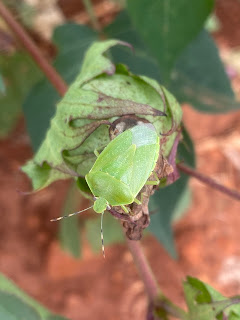Cotton
From this point forward, the bug complex of stink bugs and
plant bugs will be the most yield limiting insect situation we deal with. Stink
bugs will likely be the dominate pest complex, but we are receiving reports of
plant bugs still requiring attention in some fields across Alabama.
Bug Complex
We spent a lot of time in cotton fields across the state
this week and stink bugs and their damage were easy to find. We are still
seeing plenty of brown stink bugs as well as a mix of southern green (C and S
AL), green (N AL) and brown marmorated (both) stink bugs. For the most part,
southern green (SGSB), green (GSB) and brown marmorated (BMSB) stink bugs are
susceptible to pyrethroids and organophosphates, while brown stink bugs (BSB)
are less susceptible to pyrethroids, although using higher rates increases
control. While our thresholds are based on internal boll damage done by stink
bugs, observing the species in the field can help determine what insecticide is
needed for control. The pictures below show the different species and how to
identify them.
 |
| BMSB - Note white bands around antenna and abdomen. |
 |
| GSB - Note black bands around antennae. |
 |
| SGSB - Note red bands around antenna. |
 |
BSB - No bands around antenna. |
 |
| Stink bug damage. |
Other Pests
We are receiving reports of aphid populations crashing
across Alabama. The fungus is beginning to take over and populations are decreasing.
At this point, we probably don’t need to worry about aphids anymore. A few fields
are being treated for spider mites in NE and NW Alabama, but overall, we haven’t
heard much about mites over the past week. Based on the latest US Drought
Monitor report for Alabama, some of these areas were abnormally dry to in a
moderate drought as of July 19 (link).
If you are in a dry area and mites are present, keep in mind that populations
are easier to control when they are caught early. If the bug complex requires attention,
look for spider mite injury and the presence of active populations. Consider
mixing in a miticide if populations are active and growing. Options include
abamectin (0.15 EC formulation = 12-16 oz, 0.7 EC formulation = 2.6-3.5 oz),
Zeal, Portal or Oberon.
Soybeans
Populations of kudzu bug have exploded this year. We have
been getting reports and have seen huge populations. In most cases, eggs are hatching,
and nymphs are beginning to emerge. This is the prefect time to treat. Most
labeled pyrethroids provide excellent control of kudzu bugs.
 |
| Adult kudzu bugs with eggs and hatchings. |
The stink bug situation in soybeans seems to be fluid. Some
fields have threshold levels (4/25 sweeps) while others do not. More fields in
the Black Belt region are being treated for redbanded stink bugs. This is a
pest that we need to be aware of in soybean fields in Central and South
Alabama. Nymphs have begun to emerge, and embedded populations are building. At
this point, tank-mixtures are needed to control adult and immature populations.
High rates of bifenthrin (1 gal to 25-20 acres – or 5.12-6.4 oz) plus 0.5 to
0.75 lbs of acephate is the best option for controls. Keep in mind that there
are label restrictions for these products in soybeans. Bifenthrin can only be
applied once every 30 days, while a maximum of 1.5 lbs of acephate (a.i.) can
be applied per season. Other tank-mix options include neonicotinoid insecticides
(imidacloprid, Belay, Endigo, Leverage 360) at the highest labeled rates.
Deer Survey
In response to a farmer request, the Alabama Extension Agronomics Crops Team is conducting a survey to better understand the impacts of deer population on crop production. Please take a few moments to help us collect informtaion to try to use to figure out ways to mitigate deer losses in your row crops.
You can take the anonymous survey here (link).
Take Home Message
If you would like to provide reports or observations on the insect situation from your region, please let us know. You can reach Scott Graham at 662-809-3368 or scottg@auburn.edu or Ron Smith at 334-332-9501 or smithrh@auburn.edu.
As always, if we can ever be of any help, please let us know.